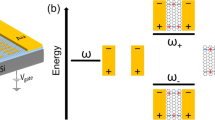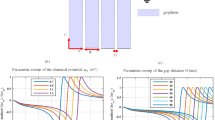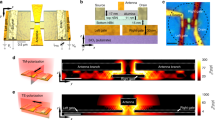Abstract
The collective oscillation of carriers—the plasmon1,2,3,4,5,6,7,8,9,10,11,12,13,14,15,16,17—in graphene has many desirable properties, including tunability and low loss11,12,13,14,16,17. However, in single-layer graphene, the dependence on carrier concentration of both the plasmonic resonance frequency and magnitude is relatively weak16,17, limiting its applications in photonics. Here, we demonstrate transparent photonic devices based on graphene/insulator stacks, which are formed by depositing alternating wafer-scale graphene sheets and thin insulating layers, then patterning them together into photonic-crystal-like structures18. We show experimentally that the plasmon in such stacks is unambiguously non-classical. Compared with doping in single-layer graphene, distributing carriers into multiple graphene layers effectively enhances the plasmonic resonance frequency and magnitude, which is different from the effect in a conventional semiconductor superlattice3,4 and is a direct consequence of the unique carrier density scaling law of the plasmonic resonance of Dirac fermions8,16. Using patterned graphene/insulator stacks, we demonstrate widely tunable far-infrared notch filters with 8.2 dB rejection ratios and terahertz linear polarizers with 9.5 dB extinction ratios. An unpatterned stack consisting of five graphene layers shields 97.5% of electromagnetic radiation at frequencies below 1.2 THz. This work could lead to the development of transparent mid- and far-infrared photonic devices such as detectors, modulators and three-dimensional metamaterial systems19,20.
This is a preview of subscription content, access via your institution
Access options
Subscribe to this journal
Receive 12 print issues and online access
$259.00 per year
only $21.58 per issue
Buy this article
- Purchase on Springer Link
- Instant access to full article PDF
Prices may be subject to local taxes which are calculated during checkout




Similar content being viewed by others
References
Ritchie, R. H. Plasma losses by fast electrons in thin films. Phys. Rev. 106, 874–881 (1957).
Allen, S. J., Tsui, D. C. & Logan, R. A. Observation of the two-dimensional plasmon in silicon inversion layers. Phys. Rev. Lett. 38, 980–983 (1977).
Das Sarma, S. & Quinn, J. J. Collective excitations in semiconductor super-lattices. Phys. Rev. B 25, 7603–7618 (1982).
Olego, D., Pinczuk, A., Gossard, A. C. & Wiegmann, W. Plasma dispersion in a layered electron gas: a determination in GaAs–(AlGa) As heterostructures. Phys. Rev. B 25, 7867–7870 (1982).
Leavitt, R. P. & Little, J. W. Absorption and emission of radiation by plasmons in two-dimensional electron-gas disks. Phys. Rev. B 34, 2450–2457 (1986).
Allen, S. J., Stormer, H. L. & Hwang, J. C. M. Dimensional resonance of the two-dimensional electron gas in selectively doped GaAs/AlGaAs heterostructures. Phys. Rev. B 28, 4875–4877 (1983).
Halas, N. J. et al. Plasmons in strongly coupled metallic nanostructures. Chem. Rev. 111, 3913–3961 (2011).
Hwang, E. H. & Das Sarma, S. Collective modes of the massless Dirac plasma. Phys. Rev. Lett. 102, 206412 (2009).
Hwang, E. H. & Das Sarma, S. Plasmon modes of spatially separated double-layer graphene. Phys. Rev. B 80, 205405 (2009).
Abedinpour, S. H. et al. Drude weight, plasmon dispersion, and ac conductivity in doped graphene sheets. Phys. Rev. B 84, 045429 (2011).
Rana, F. Graphene terahertz plasmon oscillators. IEEE Trans. Nanotech. 7, 91–99 (2008).
Koppens, F. H. L., Chang, D. E. & Javier Garcia de Abajo, F. Graphene plasmonics: a platform for strong light–matter interactions. Nano Lett. 11, 3370–3377 (2011).
Thongrattanasiri, S., Koppens, F. H. L. & Garcia de Abajo, F. J. Complete optical absorption in periodically patterned graphene. Phys. Rev. Lett. 108, 047401 (2012).
Vakil, A. & Engheta, N. Transformation optics using graphene. Science 332, 1291–1294 (2011).
Liu, Y., Willis, R. F., Emtsev, K. V. & Seyller, T. Plasmon dispersion and damping in electrically isolated two-dimensional charge sheets. Phys. Rev. B 78, 035443 (2008).
Ju, L. et al. Graphene plasmonics for tunable terahertz metamaterials. Nature Nanotech. 6, 630–634 (2011).
Fei, Z. et al. Infrared nanoscopy of Dirac plasmons at the graphene–SiO2 interface. Nano Lett. 11, 4701–4705 (2011).
Joannopoulos, J. D., Johnson, H. G., Winn, J. N. & Meade, R. D., Photonic Crystals: Molding the Flow of Light 2nd edn (Princeton Univ. Press, 2008).
Valentine, J. et al. Three-dimensional optical metamaterial with a negative refractive index. Nature 455, 376–379 (2008).
Pendry, J. B. Negative refraction makes a perfect lens. Phys. Rev. Lett. 85, 3966–3969 (2000).
Nair, R. R. et al. Fine structure constant defines visual transparency of graphene. Science 320, 1308 (2008).
Li, Z. et al. Dirac charge dynamics in graphene by infrared spectroscopy. Nature Phys. 4, 532–535 (2008).
Horng, J. et al. Drude conductivity of Dirac fermions in graphene. Phys. Rev. B 83, 165113 (2010).
Mak, K. F., Shan, J. & Heinz, T. F. Seeing many-body effects in single- and few-layer graphene: observation of two-dimensional saddle-point excitons. Phys. Rev. Lett. 106, 046401 (2011).
Yan, H. et al. Infrared spectroscopy of wafer-scale graphene. ACS Nano 5, 9854–9860 (2011).
Crassee, I. et al. Giant Faraday rotation in single- and multilayer graphene. Nature Phys. 7, 48–51 (2010).
Tinkham, M. Energy gap interpretation of experiments on infrared transmission through superconducting thin films. Phys. Rev. 104, 845–846 (1956).
Farmer, D. B. et al. Utilization of a buffered dielectric to achieve high field-effect carrier mobility in graphene transistors. Nano Lett. 9, 4474–4478 (2009).
Falkovsky, L. A. & Pershoguba, S. S. Optical far-infrared properties of a graphene monolayer and multilayer. Phys. Rev. B 76, 153410 (2007).
Li, X. et al. Large-area synthesis of high-quality and uniform graphene films on copper foils. Science 324, 1312–1314 (2009).
Bae, S. et al. Roll-to-roll production of 30-inch graphene films for transparent electrodes. Nature Nanotech. 5, 574–578 (2010).
Acknowledgements
The authors are grateful to B. Ek and J. Bucchignano for technical assistance and DARPA for partial financial support through the CERA programme (contract no. FA8650-08-C-7838).
Author information
Authors and Affiliations
Contributions
F.X., P.A. and H.Y. conceived the experiments. F.X. and H.Y. fabricated the devices. H.Y. performed the measurements and data analysis. X.L. and B.C. grew the chemical vapour deposition graphene. G.T. helped with doping. M.F. helped with the experimental set-ups. Y.W. and W.Z. participated in sample fabrication and characterization. F.X. and H.Y. co-wrote the manuscript. P.A. provided suggestions, and all authors commented on the manuscript.
Corresponding authors
Ethics declarations
Competing interests
The authors declare no competing financial interests.
Supplementary information
Supplementary information
Supplementary information (PDF 449 kb)
Rights and permissions
About this article
Cite this article
Yan, H., Li, X., Chandra, B. et al. Tunable infrared plasmonic devices using graphene/insulator stacks. Nature Nanotech 7, 330–334 (2012). https://doi.org/10.1038/nnano.2012.59
Received:
Accepted:
Published:
Issue Date:
DOI: https://doi.org/10.1038/nnano.2012.59
This article is cited by
-
Numerical investigation of MXene-based ultrawideband solar absorber with behaviour prediction using machine learning
Optical and Quantum Electronics (2024)
-
Black Phosphorus–Based Metamaterial Double-Band Anisotropic Absorber for Sensing Application in Terahertz Frequency
Plasmonics (2024)
-
An investigation of the influence of the graphene layers number on the performance of surface plasmon resonance biosensors with various thicknesses of silver
Journal of Optics (2024)
-
Tunable optical topological transitions of plasmon polaritons in WTe2 van der Waals films
Light: Science & Applications (2023)
-
Conducting fillers based multilayer polymer composites for terahertz absorber applications
Bulletin of Materials Science (2023)



